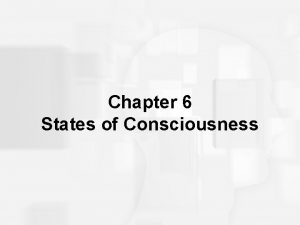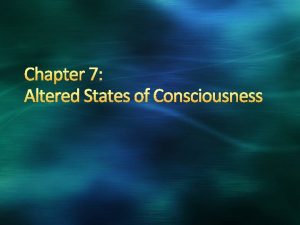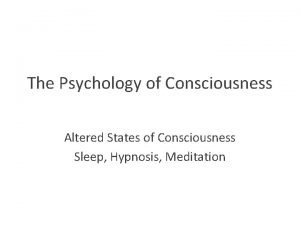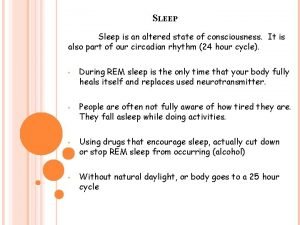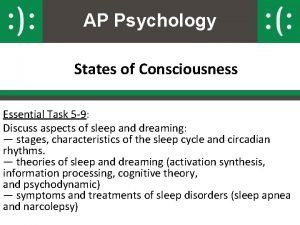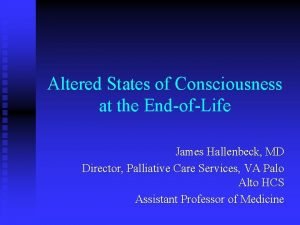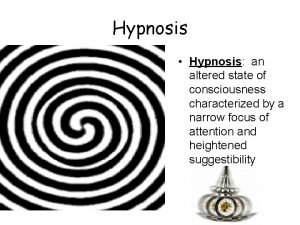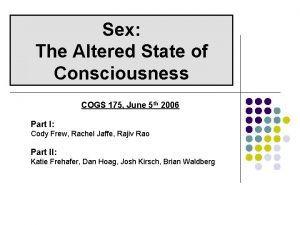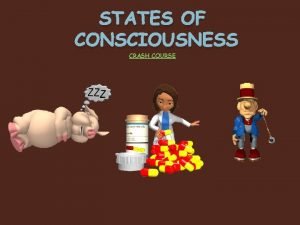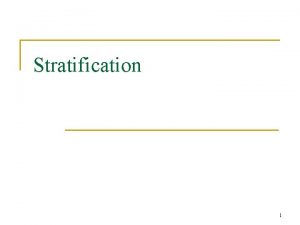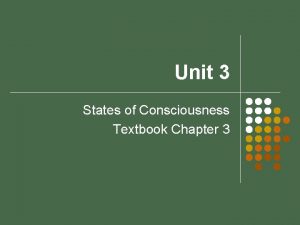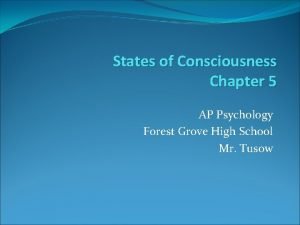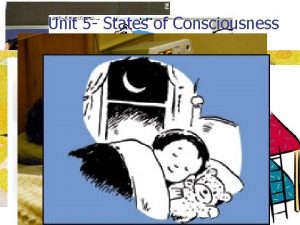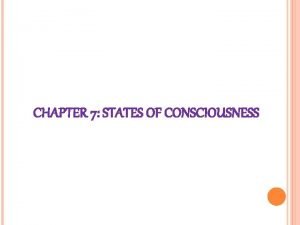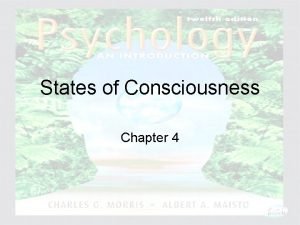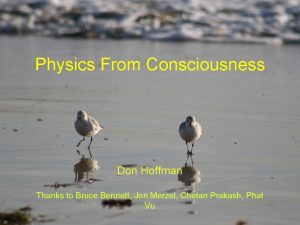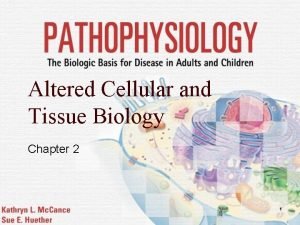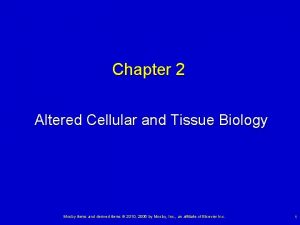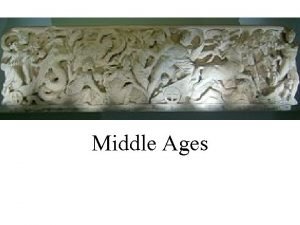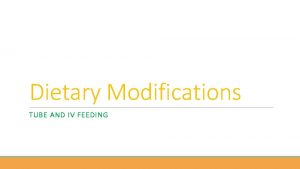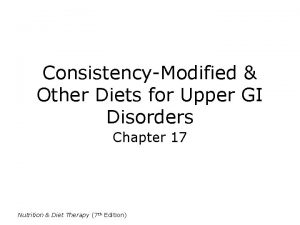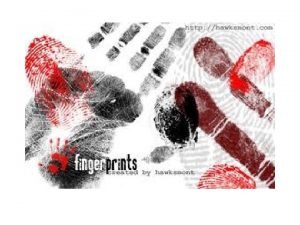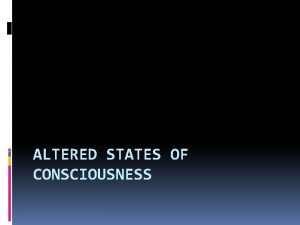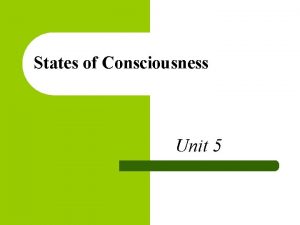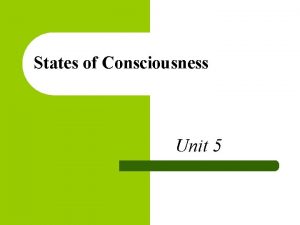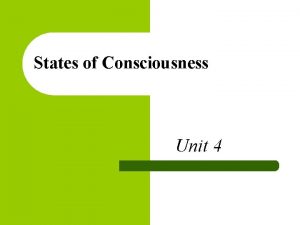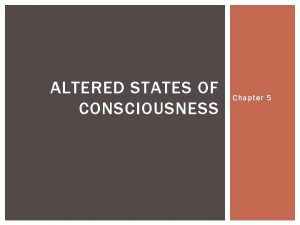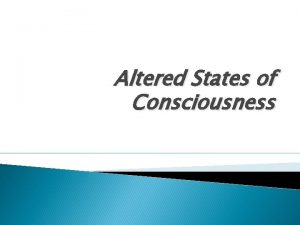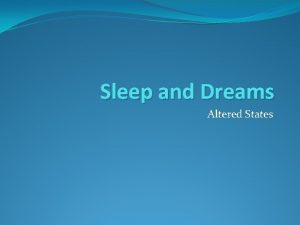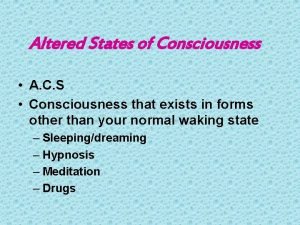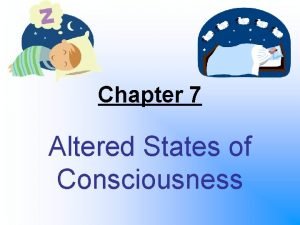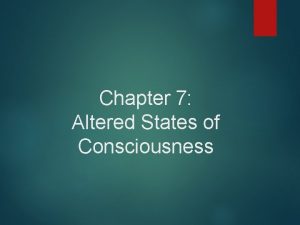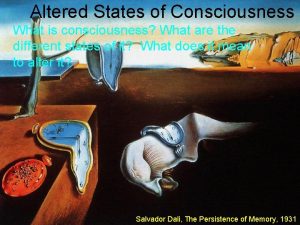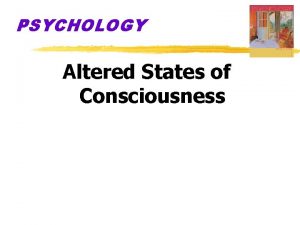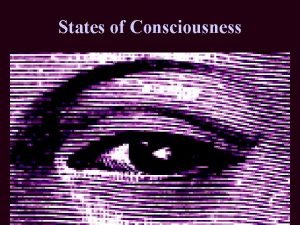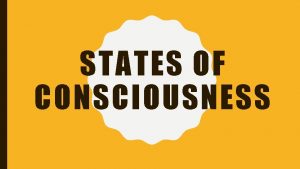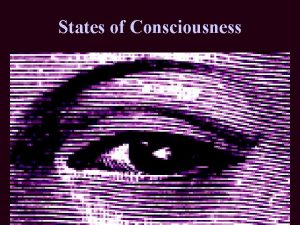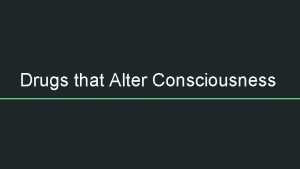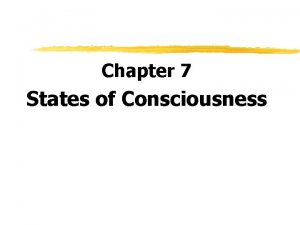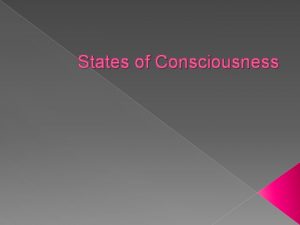CONSCIOUSNESS AND ITS ALTERED STATES Consciousness This involves
































- Slides: 32

CONSCIOUSNESS AND ITS ALTERED STATES

Consciousness This involves awareness and intention. It is defined as selective attention to ongoing perceptions, thoughts, and feelings. The awareness of things that are both inside and outside ourselves Selective Attention • Our conscious attention is selective. • This means that at any moment awareness focuses on only a limited aspect of all that we are capable of experiencing. • In short the focusing of conscious awareness on a particular stimulus

Self Awareness The absorption of sense of self in the present to forgetting oneself Waking Consciousness • Thoughts, feelings, ad perceptions that occur when we are awake and alert Altered States of Consciousness • A mental state that differs noticeably from normal waking consciousness, including sleep, dreaming, meditation, or druginduced states

Levels of Consciousness Conscious mind Sub/Preconscious mind Contains the contents of our immediate experiences Information can be purposefully manipulated Contains memory traces that can be recalled with relative ease Most likely associated with information that can be retrieved from our long term memory Unconscious mind Information stored in this level is unavailable to awareness under most circumstances Freud believed that it is a locus of deep seated and largely inaccessible drives and desires


Sleep and Dreams • The sleep cycle is made up of four stages of sleep and REM sleep. • Sleep serves important physical and psychological needs. • Common sleep problems include insomnia, nightmares, night terrors, sleepwalking, sleep apnea, and narcolepsy. Circadian rhythm the biological clock roughly corresponds to 24 -hour day/night cycle cyclical bodily rhythms wakefulness body temperature

Why do we need sleep? Protective kept our early ancestors from navigating at night Recuperation restore and repair brain tissue Remembering restore & rebuild memories from the day Growth growth hormone released during deep sleep

The Sleep Cycle • Much of how people, animals, and plants function is governed by circadian rhythms, or biological clocks. • Circadian rhythms in humans include a sequence of bodily changes that occurs every 24 hours. • The most studied circadian rhythm is the sleep-wake cycle. The Stages of Sleep REM Sleep • • • Sleep stages are described in terms of brain-wave patterns. There are five stages of sleep. Stage 1 is the lightest stage of sleep. Stage 4 is the stage of deepest sleep. • • After about 30 minutes of stage 4 sleep, we return to stage 3, then stage 2, and then stage 1 sleep. This takes about 90 minutes. Then another stage of sleep begins. It is called rapid-eye-movement sleep, or REM sleep. Beneath the closed lids, the eyes move rapidly.

Sleep Stages Cycle through 5 sleep stages every 90 minutes Stage 1 Sleep Stage 2 Sleep brief; transitioning to deeper sleep Stage 4 Sleep 20 minutes; spindles (bursts of brain activity) Stage 3 Sleep brief stage; sensation of falling 30 min. ; delta (large, slow) brain waves; deep sleep REM Sleep 10 minutes; vivid dreams

Sleep Stages REM (Rapid Eye Movement) Sleep recurring becomes longer as night goes on vivid dreams paradoxical sleep externally calm (muscles) internally aroused (heart rate)

Brain Waves and Sleep Stages Alpha Waves slow brain waves of a relaxed, awake state Delta Waves large, slow waves of deep sleep stage 3 and stage 4 Hallucinations false sensory experiences stage 1: may experience hallucinationlike images

The Importance of Sleep and Dreams • People need sleep to revive the tired body and build up resistance to infection. • Sleep may help people recover from stress and consolidate memories. • REM sleep seems to help animals and people learn, remember, and retain information. Dreams The Freudian View • • • REM sleep is when we have the most vivid dreams. People dream in color and in black and white. People seem to dream in “real time. ” People do not always remember their dreams. • Sigmund Freud theorized that dreams reflect a person’s unconscious wishes and urges. He also believed people dream in symbols as a way to deal with painful material they cannot otherwise deal with consciously.

Dreams (REM) images, emotions, and thoughts passing through a sleeping person’s mind hallucinatory imagery discontinuities incongruities vivid recall: if we are awakened during REM sleep (or right after)

Dreams - Freud Manifest Content remembered story line of a dream includes real experiences from the day Latent (Hidden) Content underlying meaning of a dream Freud: uncovering this hidden meaning can help people resolve personal issues

Sleep Problems Insomnia • Insomnia is the inability to sleep. • The most common type of insomnia is difficulty in falling asleep. • Many psychologists believe that the best ways to overcome insomnia do not involve medication. • They recommend using relaxation techniques, establishing regular bedtimes, and using pleasant images to relax. Nightmares and Night Terrors • Nightmares are a product of REM sleep. • People who are anxious or depressed are more likely to have nightmares. • Night terrors are similar to nightmares but they are more severe. • Night terrors tend to occur during deep sleep.

Sleepwalking • Many children walk in their sleep. • Most children outgrow sleepwalking as they mature. Sleep Apnea • Sleep apnea is a breathing interruption that occurs during sleep. • About 10 million Americans have sleep apnea. Narcolepsy • Narcolepsy is a rare sleep problem in which people suddenly fall asleep, no matter what time it is or where they are. • It is believed to be a genetic disorder of REM-sleep functioning.


Hypnosis: Myths and Realities Hypnosis is a condition in which people appear to be highly suggestible and to behave as if they are in a trance. Some psychologists believe that hypnosis is an altered state of consciousness. Others wonder whether hypnosis is truly an altered state of consciousness. The History of Hypnosis Achieving Hypnosis • Hypnosis dates back to the late 1700 s with the work of Franz Mesmer. • Today doctors and psychologists use hypnosis in a variety of ways: as an anesthetic, to help reduce anxiety, manage pain, or overcome fears. • Professional hypnotists may put people into a hypnotic trance by asking them to focus on something specific. • People who are easily hypnotized are said to have hypnotic suggestibility.


The Uses of Hypnosis and Memory • Hypnosis is not a reliable approach to help people remember details of a crime. • Many psychologists argue that material recalled under hypnosis should not be used as testimony in trials. Hypnosis and Pain Prevention • Hypnosis has been used to help people prevent pain. • A similar effect can be achieved through relaxation techniques and breathing exercises. Hypnosis and Quitting Bad Habits • Therapists may use posthypnotic suggestion to help people quit a bad habit. • In posthypnotic suggestion, therapist gives instruction during the hypnosis that the patient is to carry out after the session has ended.

Drugs & Consciousness Psychoactive chemicals Drugs that change perceptions & moods Tolerance brain adapts chemistry to offset drug effects increasingly larger doses are needed to get the effect Withdrawal discomfort following the discontinuation of a drug

Dependence & Addiction Physical Dependence indicated by physical pain and craving when the drug is absent Psychological Dependence not physically addictive, but user has a psychological need to use the drug stress-relieving drugs Addiction compulsive drug craving and use

Addiction Myths Addictive drugs quickly corrupt (False) In most cases addiction does not occur when drugs are used medically Example: Those given morphine to control pain do not crave the drug like addicts who use morphine to change their mood Even with highly addictive drugs (cocaine) only some people (about 15%) become addicted Therapy is required to overcome addictions (False) Therapy & group support is helpful, but people do also recover on their own

Depressants • Many drugs are addictive. Addiction to a drug means that after the person takes that drug for a while, the body craves it just to feel normal. • Depressants are drugs that slow the activity of the nervous system. Alcohol Narcotics • Alcohol is the most widely used drug in the United States. • Alcohol is a depressant. • Narcotics are addictive depressants used to relieve pain and induce sleep. • It causes intoxication, or drunkenness. • Many are derived from the opium poppy plant. • Regular consumption can lead to addiction. • They include morphine and heroin.

Stimulants • Stimulants increase the activity of the nervous system. • They include nicotine, amphetamines, methamphetamines, and cocaine. Nicotine Amphetamines • Nicotine is one of the most common stimulants. • Amphetamines are stimulants often used for staying awake or reducing appetite. • It spurs release of adrenaline. • Regular use can lead to addiction. • Nicotine is found in tobacco. • Cigarette smoking is as addictive as heroin. • They can cause hallucinations, perceptions that seem to be real but are not, and delusions, false ideas that seem real. • One extremely addictive form is methamphetamine.

Cocaine • Cocaine is a stimulant derived from the leaves of the coca plant. • It raises blood pressure, increases heart rate, and decreases supply of oxygen. • Use of cocaine can sometimes cause death. • One very harmful form is known as crack.


Hallucinogens • A hallucinogen is a drug that produces hallucinations. Marijuana LSD • Produced from the leaves of the cannabis sativa plant • Can produce intense hallucinations • May produce feelings of relaxation and mild hallucinations • Can cause injury or suicide • Impairs perception, coordination, memory, and learning • Can have severe effects on consciousness • Sometimes called acid • Side effects include memory loss, violent outbursts, nightmares, and panic

Other Hallucinogens • Mushrooms that contain psilocybin, which produces altered perceptions, confusion, anxiety, and panic • Peyote, which contains mescaline • Ecstasy, a pill that produces hallucinations, increased energy, loss of judgment, and serious side effects including nausea and high blood pressure

Drug Use Influences Biological Factors Adopted individuals more susceptible to alcoholism if one or both parents have history Genes identified that are more common among people predisposed to alcoholism Psychological Factors Feeling that life is meaningless Stress Psychological disorders (e. g. , depression)

Drug Use Influences Social-cultural peer influences influence cultural attitude toward drug use urban environment

 Lesson quiz 7-1 altered states of consciousness
Lesson quiz 7-1 altered states of consciousness Feelings in a dream chapter 7
Feelings in a dream chapter 7 Chapter 7 altered states of consciousness
Chapter 7 altered states of consciousness Altered state of consciousness psychology
Altered state of consciousness psychology An altered state of consciousness
An altered state of consciousness Altered state of consciousness psychology
Altered state of consciousness psychology Altered state of consciousness psychology
Altered state of consciousness psychology Altered state of consciousness psychology
Altered state of consciousness psychology Hypnotic states
Hypnotic states Sex altered state of consciousness
Sex altered state of consciousness Crash course states of consciousness
Crash course states of consciousness Altered states game
Altered states game Types of social mobility
Types of social mobility 3 states of consciousness
3 states of consciousness Latent dreams definition
Latent dreams definition 7 states of consciousness
7 states of consciousness Unit 5 states of consciousness answers
Unit 5 states of consciousness answers Chapter 7 states of consciousness
Chapter 7 states of consciousness Ap psychology states of consciousness
Ap psychology states of consciousness Unit 5 states of consciousness
Unit 5 states of consciousness Altered cellular and tissue biology
Altered cellular and tissue biology Altered cellular and tissue biology
Altered cellular and tissue biology Slave states free states
Slave states free states Northern and southern states
Northern and southern states Big states vs small states guard against tyranny
Big states vs small states guard against tyranny The emigree annotations
The emigree annotations Its halloween its halloween the moon is full and bright
Its halloween its halloween the moon is full and bright Papal states at its height
Papal states at its height Modular enteral formula example
Modular enteral formula example Mechanically altered diet
Mechanically altered diet Altered cognition in older adults is commonly attributed to
Altered cognition in older adults is commonly attributed to Altered cast technique indications
Altered cast technique indications Can fingerprints be altered or disguised
Can fingerprints be altered or disguised
